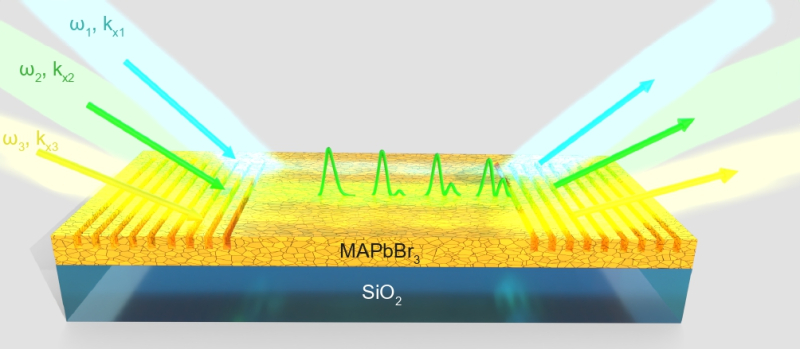Optical computers are impossible without advances in integrated photonics, such as ultrafast optical chips, which transport data using photons rather than electrons. One advantage of using photons is that they have a greater capacity and therefore can transmit data over longer distances without attenuation or distortion.
Direct photon-by-photon transmission, however, can hardly be achieved due to the linear character of light particles. To control light with light, researchers need a mediator, i.e. a nonlinear optical material. The optical properties of such materials rely heavily on light intensity and when altered, it can be used to control the flow of photons carrying data – for instance, block or let them through. A nonlinear medium is similar to a crossing guard: it determines which light pulse can pass through.
Recently, researchers started to increasingly use exciton-polaritons for nonlinear optical materials. These are hybrid quasiparticles that emerge as a consequence of light interacting with electron-hole pairs. They exhibit low optical losses, high speed and coherence (of photons, as all photons are identical), and great optical nonlinearity (of excitons). Altogether these characteristics make exciton-polaritons the perfect candidate for ultrafast optical processes, but the issue is that these quasiparticles can exist in most common materials only at extremely low temperatures.
A team of researchers from Russia, Germany, Switzerland, Turkey, and the UK was first to produce optical components based on exciton-polariton waveguides using halide perovskites. Their development has several advantages: firstly, perovskites are easy and quick to make, and secondly, exciton-polaritons can exist in them even at room temperatures.
“To stretch the crossing-guard analogy: we developed a waveguide or let’s say a “street” – a custom platform for the MAPbBr3 perovskite (over 100 nm thick) through which light pulses travel just like cars. In order for photons to “enter” or “leave” the “street”, we formed input and output elements for them – the so-called “exits” from the “street.” But our “street” is different; it’s nonlinear, which means that it alters under the influence of passing pulses. Thus, a photon-”runabout” barely touches the surface, whereas a bulky truck – a ultrashort intensive pulse – “kneads the asphalt” and changes its properties. We were first to look into how such pulses travel in perovskite waveguides and show that these materials exhibit solid nonlinear properties. This finding paves the way for creating ultrafast optical chips that will make light-to-light control possible – without the use of electronics,” explains Nikita Glebov, an author of the paper and an engineer at ITMO’s Faculty of Physics.

Nikita Glebov. Photo by Dmitry Grigoryev / ITMO NEWS
As they changed the energy and frequency of an input pulse, the team documented several nonlinear optical phenomena that distinguish halide perovskites. For one, the pulse can divide itself into two, as well as change its shape and width. The study also showed that the platform supports two essentially different pulse modes – from forming optical solitons resistant to change during data transmission to a shock wave. By controlling the transition between these modes, the researchers can easily control the strength of a nonlinear medium and potentially develop predictable and flexible ultrafast chips, transistors, and other optical devices based on halide perovskites.
“Perovskites are a brand new medium for producing optical integrated circuits. They are cost-efficient and can be used to create ultrafast and intense modulations of an optical signal. However, if we want to build a full-fledged photonic integrated circuit based on perovskites, we need to figure out some technical challenges first. In particular, we’re currently working to complement our design with an extra modulation channel using optical or electrical influence for optical computing – and hence ultrafast optical transistors. Aside from that, we also continue our research in the field of ultrasensitive gas sensors,” says Sergey Makarov, an author of the paper and a chief researcher at ITMO’s Faculty of Physics.

Propagation of exciton-polariton wave packets in a waveguide based on halide perovskites. Photo courtesy of Nikita Glebov
Read also:
Optical Computers Explained: Will They Replace the Regular Kind?
Power Without Electricity: Nanodevice For Optical Computers Developed at ITMO





